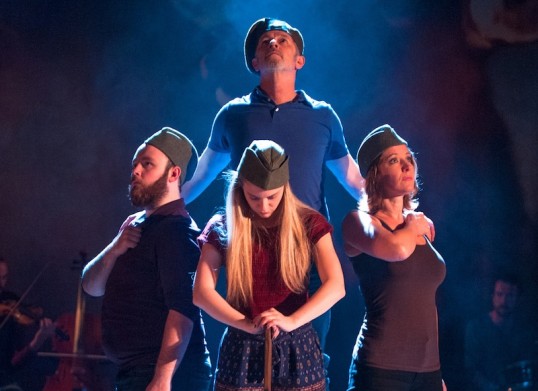The Cheviot The Stag…
★★★★★ Fabulous revival
Dundee Rep: Fri 11 – Sat 26 Sept 2015
Big, bold, brilliantly political and a cracking night out to boot, Dundee Rep’s revival of The Cheviot The Stag and the Black, Black Oil makes the theatre a must-visit venue this month.
It’s not often that Æ ventures to review outside Edinburgh, but being in Dundee for the opening night of the show it would be utterly churlish not to recommend a trip up to see it.
The Cheviot might have its heart in the Highlands and Islands but the show does have an Edinburgh connection. It was first performed here, on March 31 1973, having been concocted and created in two short weeks by John McGrath and his newly convened 7:84 Scotland Theatre company, labouring collectively on its research in an upper room of the then Odeon Cinema on South Clerk Street.
In the intervening years the world has moved on immeasurably, of course. The very nature of political involvement has changed, knowledge has become public property, nylon has stopped being clever and, in the politics of energy, fracking has become the hot political potato, with the mining industry destroyed and wind power offering a new hope for community ownership.
None of which has effected the thrust and plot-line of the robust and heartfelt piece of ceilidh theatre which is at the core of what makes the Cheviot such success. And in the Dundee Rep production, this is understood in buckets.
This is all about the people. It is the people’s story. And director Joe Douglas, MD Alasdair Macrae and their nine-strong ensemble company make the people a part of its telling.
They are there on stage in Graham McLaren’s open-plan design. About 50 of them are actually sitting on the stage, in amongst the action in a manner which evokes the first big tour of the show, out to the smallest and remotest halls around Scotland.
An event from the word go
And when the house opens, the cast are already on stage, cooking up some tunes and handing out the drams to those who have bought their raffle tickets in the foyer before. It makes the whole play an event from the word go, wandering across the stage, sharing a grin with those about to relate the show, and meeting people you only glimpsed on the busy 17.37 commuter train from Waverley.
And the story they relate, one with “a beginning and middle but not yet an end”, is of the Highland clearances. The bringing to life and relevance of that shoddy piece of history, hidden right under our noses. Not as a lament, as is so often the case, but as a cry of passion and anger stemming from the knowledge that those who do not understand the past are condemned to repeat it.
It is packed with real villains. Made pantomime boo-able in the unfettered structure of the piece. Not that they need the uniform of the panto. Billy Mack has enough with a high top hat as the odious factor, Sellar, who was only doing his job when he brought about the clearances of the Sutherland Estate in 1813. That, and the words he spoke about the people he regarded as a parcel of beggars.
But it is in that element of breaking the fourth wall – with facts as well as jokes – that this powers forward. Music is always there: traditional Scottish reels which permeate its fabric; big thrusting rock’n’roll electric riffs when the Americans come to buy up Scotchland and its oil for themselves.
It’s not all dire news, however. It’s also the story of how people did stand up in places and were successful in stopping the evictions, and of how women were nearly always at the heart of that revolt. How, when men returned from war, they forced the landowners to honour their promises of a place to live.
It’s lampooning the toffs and landed gentry who own the Highlands, mocking the politicians – and pointing their vested interests – who allowed Scotland to be sold off. In this it is brought right up to the contemporary mark with the super-buff John Macauley parading around in nothing more than a pair of shorts and a Cameron mask – apart from the Union Flag pants which he reveals, displaying them to a hooting audience.
Top notch
And right the way down the cast the performances are top notch. Lively, invigorating, realistic when needed but more often than not caricature. There’s Stephen Bangs’ sturdy Minister crying for the owners from pulpit, Christina Gordon constantly on the ball in supporting roles, and Jo Freer as local profiteer Andy McChuckemup or creating haunting melody with the harp and her take on Mary MacPherson’s Gaelic Song about the clearances.
All of them wheel in and out of characters and take up the role of storyteller. Calum MacDonald provides the only native Gaelic speaker, Irene Macdougall is imperious as the main storyteller, Alasdair Macrae a sneering American oilman, Martin McBride a snooty Victorian toff and Emily Winter ranging from a crinolined Harriet Beecher Stowe to Lord Polwarth and a raft of characters between.
There are many reasons to want to see The Cheviot the Stag and the Black, Black Oil. Not least because it is a slice of modern theatre history, a play which changed something about what theatre can be.
That is true in Dundee Rep’s production. But do not go looking for a repetition of a historical performance. This astute new revival understands its history and has recreated it, not repeated it, for the here and now.
Running time 2 hours 40 minutes.
Dundee Rep, Tay Square, Dundee, DD1 1PB
Box Office: 01382 223530
Friday 11 – Saturday 26 September 2015
Tue-Sat: 7.30pm; matinees: Thurs, Sat: 2.30pm.
Website: www.dundeerep.co.uk/event/cheviot
The Bloomsbury edition of the script (left), edited with commentary and notes by Graeme MacDonald, is well worth having. Or you can get a kindle edition (right).
ENDS























Comments (1)
Trackback URL | Comments RSS Feed
Sites That Link to this Post